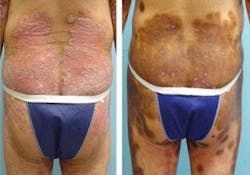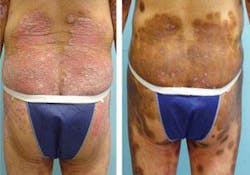Laser treatment relieves even severe skin conditions
A new laser-based treatment for psoriasis and vitiligo leaves unaffected skin unexposed—and breaks ground for severe cases.
By Paul TanPiengco
The National Psoriasis Foundation recently noted that excimer lasers have been approved by the FDA for psoriasis and are effective in treating people with mild to moderate plaque psoriasis—those with less than 10 percent of the body covered by psoriasis or lesions localized to specific areas of the body.
But what about people with more severe cases? A new study indicates that they, too, can get dramatic relief with the help of laser treatments.
Chronic but mild
The XTRAC excimer laser system (XTRAC Ultra and XTRAC Velocity) from PhotoMedex represents a new option for treatment of psoriasis, a common cause of itchy, scaly and sometimes inflamed patches. In addition, it has been shown effective in treating another chronic skin condition, vitiligo, which causes loss of pigment and results in irregular pale patches.
The system uses narrowband ultraviolet-B phototherapy for the treatment of localized psoriasis, which encompasses about 90% of the psoriatic population. People with mild to moderate psoriasis can often obtain relief in 10 to 12 treatment sessions. Relief can last up to six months.
This method of treatment offers several advantages over more traditional therapies: it involves no messy gels or creams, nor are there potential adverse effects from the steroids that are included in some topical medications. Other drawbacks associated with traditional psoriasis treatments include premature aging of healthy skin, skin thinning, and resistance to medication.
The laser-based technology uses a carefully focused beam of light that is delivered through a sophisticated handpiece. Because the system concentrates light on active lesions it delivers the energy to where the treatment is needed, while minimizing the risk to healthy skin.
The system is similar in many ways to traditional ultraviolet B (UVB) light therapy, which has been an effective treatment for psoriasis for many years. It emits a high-intensity beam of UV light measured at a wavelength of 308 nm—which is close to that delivered by narrowband UVB units. This wavelength slows the rate at which skin cells of psoriasis plaques multiply.
Unlike full-body UVB treatment in which all of the skin is exposed to the light and its potentially harmful side effects (including burning and accelerated aging), the XTRAC uses a beam less than one inch in diameter, and thus spares uninvolved skin,
Treatments and results
In a study in which 124 patients with mild to moderate psoriasis enrolled and 80 patients completed, the mean number of treatments needed was 10. Of those, 72% achieved at least 75% improvement in their psoriasis, after an average of 6.2 treatments. At least 90% improvement was seen in 35% of the patients, after an average of 7.5 treatments. The most common side effects were redness, blistering, temporary changes in skin color and shallow erosion of the skin.
How well an individual will respond to the treatment varies. It takes an average of 10 to 12 sessions to see results, depending on the particular case of psoriasis. It is recommended that patients are treated twice per week, with a minimum of 48 hours between treatments. Therefore, a series of 10 treatments would take approximately five weeks.
Each treatment should only last a few minutes, depending on how extensive the areas being treated are. For example, treating an average-size elbow lesion would take about one minute.
Skin with psoriasis can handle more UV light than unaffected skin, so higher doses can be used with the laser compared to traditional UVB units. For those who respond, this should mean quicker results: in 10 to 12 or fewer laser sessions compared to 30 to 40 treatments for regular UVB.
The treatment should not hurt, although patients might feel warmth. Afterward, patients are instructed to avoid sun exposure and trauma to the treated areas. If blistering occurs, the physician should be contacted, and treatment with an antibiotic ointment may be recommended.
The long-term safety record of UVB phototherapy is very good, with no clearly established higher risk of skin cancer among treated patients. This new therapy should be as safe or safer, particularly because the skin without psoriasis is spared light exposure.
More severe cases
Recently, this new approach was also found to be highly effective in treating moderate to severe psoriasis patients. The results of a pilot study released in May 2008 revealed that the treatment enabled a 75% to 90% improvement in the psoriasis-area-and-severity-index (PASI) scores for appropriate patients with moderate to severe cases.
“This is welcome news for both doctors and patients in treating moderate to severe psoriasis,” said John Koo, M.D., professor and vice chairman of the University of California, San Francisco, Department of Dermatology, where the study was conducted. “The XTRAC excimer laser is breaking new ground in the safe, effective, convenient treatment of this difficult skin condition.”
The system’s ability to deliver high therapeutic doses of energy is necessary to quickly and conveniently treat large areas of psoriasis commonly seen in severe psoriasis.
The study measured patients at the beginning and end of a 12-week period of average twice-weekly treatment. Patients represented typical moderate to severe psoriasis, having a body surface area (BSA) with the disease of 10% to 20% and Fitzpatrick skin type better than 1.
At week 12, more than 77% of the patients exhibited a greater than 75% improvement in their PASI score and 44% of the patients exhibited a greater than 90% improvement in PASI score. Clearing was achieved with approximately 10 treatments.
According to the study, the XTRAC excimer laser may be appropriate for the majority of moderate to severe psoriasis sufferers.
Paul TanPiengco, who holds a masters degree in neurophysiology, is director of marketing at PhotoMedex, 147 Keystone Drive, Montgomeryville, PA 18936; www.photomedex.com.

